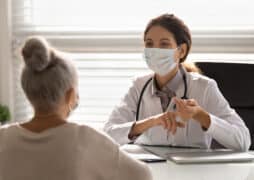Today, National Breast Cancer Awareness Month is about more than awareness of the disease – it is about making people aware of the challenges that remain, it is about removing barriers to care for the people it affects, it is about reducing the disparities that exist across races, genders and ethnicities, and it is about reminding people that one in eight women will be diagnosed with breast cancer in her lifetime.
Nearly 279,000 women and men will be diagnosed with breast cancer, and 42,000 are expected to die from breast cancer in the U.S. alone. Since Komen’s inception in 1982, it has provided more than $1 billion in funding for researchers working to end this disease. Through research grants, scientists have been able to better understand breast cancer and develop better treatments. As a result, more lives are being saved. But there is still work to be done to save lives, and help people live better lives, longer.
What is breast cancer?
Breast cancer is a disease where the cells in the breast tissue grow out of control. As they grow, they can form a mass or a lump, called a tumor. Some of these tumors that form in the breast are malignant, or cancerous. The cells of these tumors can spread into the surrounding breast tissue in a process called invasion, or invasive breast cancer. Along with that ability to spread within the breast comes the ability of these cells to break away from that tumor in the breast and spread to other organs of the body. This process is called metastasis and leads to metastatic breast cancer.
How do you get it?
No one really knows why breast cancer develops in a certain person at a certain time. We know it develops as a result of a gene mutation. Some gene mutations are inherited from our parents and these account for about 5 to 10 percent of breast cancer in the U.S. But 90 to 95 percent of breast cancers occur as a result of a spontaneous gene mutation that occur during a person’s lifetime. We don’t know what causes these mutations. They could be due to lifestyle or to exposure to an environmental toxin. We don’t even know that if we could understand them, we could prevent them.
Why should someone with no history care about breast cancer?
We know there are certain factors that increase our chance of getting breast cancer, such as having an inherited gene mutation, or being overweight as an adult, or taking menopausal hormones. But not everyone with an inherited mutation or is overweight or takes menopausal hormones gets breast cancer. In fact, most don’t. We know the two most common risks for breast cancer are being female and getting older. But some men get breast cancer and some young women get breast cancer, too. So, what it boils down to is everyone is at risk of developing breast cancer – even people who are healthy, eat right, exercise, are an ideal weight and have no family history of the disease. And with more than 279,000 women and men in the U.S. expected to be diagnosed with breast cancer this year, alone, chances are you know someone who will be affected by breast cancer.
What should you know about the disease?
We know more about breast cancer than ever before. We know it isn’t just one disease, but a family of diseases – each with a different “personality”, characteristics, appearances and behaviors. We know there at least four main subtypes of breast cancer, and there are at least an additional six subtypes for one of the four. This information has led researchers to learn more about specific types of breast cancer and develop specific treatments that aim to kill the cancer cells and prevent them from recurring or coming back. We know mammograms can find breast cancer early, up to 10 years before it would be large enough to feel. We know if breast cancer is found early, there are more treatment options, and the outcomes are better. But even with this better understanding, better and treatments and screening programs, we don’t have all the answers. We don’t know why some breast cancers go into hiding after treatment only to recur years later as metastatic breast cancer. We don’t know why breast cancer mortality rates are 40 percent higher in Black women than in white women. We don’t know why more than 42,000 women and men in the U.S. will die from breast cancer this year.
Until we have these answers and have prevented breast cancer from coming back, our work is far from over. So is National Breast Cancer Awareness Month.



